Whether you are a stay at home mom or a busy working mom, doing the dishes can be an annoying chore that takes up too much of your time! But it doesn’t have to be that way!
With a few simple tips and tricks, you can make washing dishes easier and faster, I promise!
Like all chores, it still has to be done by someone at the end of the day. And it’s pretty unavoidable unless you are serving dishes and meals on paper plates (which I have done and still do from time to time). Even then, the cookware must be cleaned.
But washing dishes doesn’t have to be the hassle it can sometimes appear to be.
In this article, I’m going to share my best tips for washing dishes to make it a faster, if not a more enjoyable, experience. Keep reading to learn more!
*This post contains affiliate links. Full disclosure here.

Make Washing Dishes Easier By Having the Right Tools
When tackling dirty dishes, it’s best done with only the best tools available at your disposal. I’ve tried a lot of various soaps, sponges, and scrubbers. Here are my top tips for dishwashing products.
1. Use a Top Dish Soap
Quality dish soap makes all the difference! I always look for brands with a few key characteristics.
The foremost is effectiveness – does the product get all types of stubborn food and grease off your dishes? Does it leave any residue or remain on plates after rinsing?
I also consider scent; if you’re not a fan of heavily perfumed soaps, you may prefer something more subtle. But I admit, I love dish soaps that smell good!
Additionally, some dish soaps are formulated with specific cleaning agents that can be helpful in particular uses.
For instance, some are designed specifically to fight hard water spots, while others tackle tough food particles without harsh scrubbing. Eco-friendly products that don’t contain phosphates may also be a better choice for your home.
My go-to is Dawn, it gets rid of tough stains, and a little bit goes a long way! I buy it in bulk so it’s cheaper, then I transfer it to a smaller bottle that I keep by the sink.
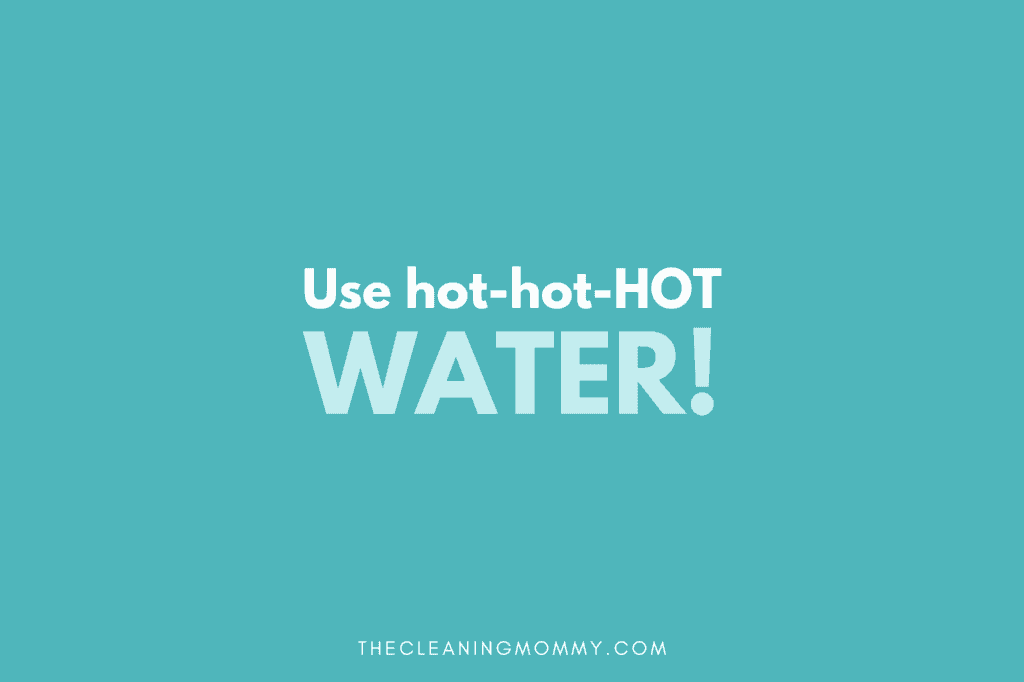
2. Use hot-hot-HOT water.
Hot water breaks down food particles and removes grease, dirt, and bacteria from utensils and dirty dishes. It also helps to prevent the spread of germs and cross-contamination from one dish to another.
I always fill my sink with the hottest water only. Of course, you don’t want to fill it with scalding water, but hotter water is the key to clean dishes.
Pro Tip: Before you start washing dishes, make sure the sink is clean so that you don’t contaminate the dishes with any previous residue. The last thing you want is leftover raw chicken juices in the sink to ruin a nice sinkful of water meant for dishes.
When To Use Cold Water
Sometimes, Life happens. Your hot water heater may be on the blink, or if you live in a particularly cold climate, it may not be as hot as you want it. I get it; I’ve been there!
Cold water is…acceptable for washing dishes. I say ‘acceptable’ because most dish soaps work best with hot water.
Some proteins are more easily dissolved in cold water than in hot water. But water really just facilitates the cleaning process that soap is the main component of.
If you must use colder water, make sure you scrap all stuck on food particles and grease from dishes, pans, and bowls as best you can first, and really scrub!
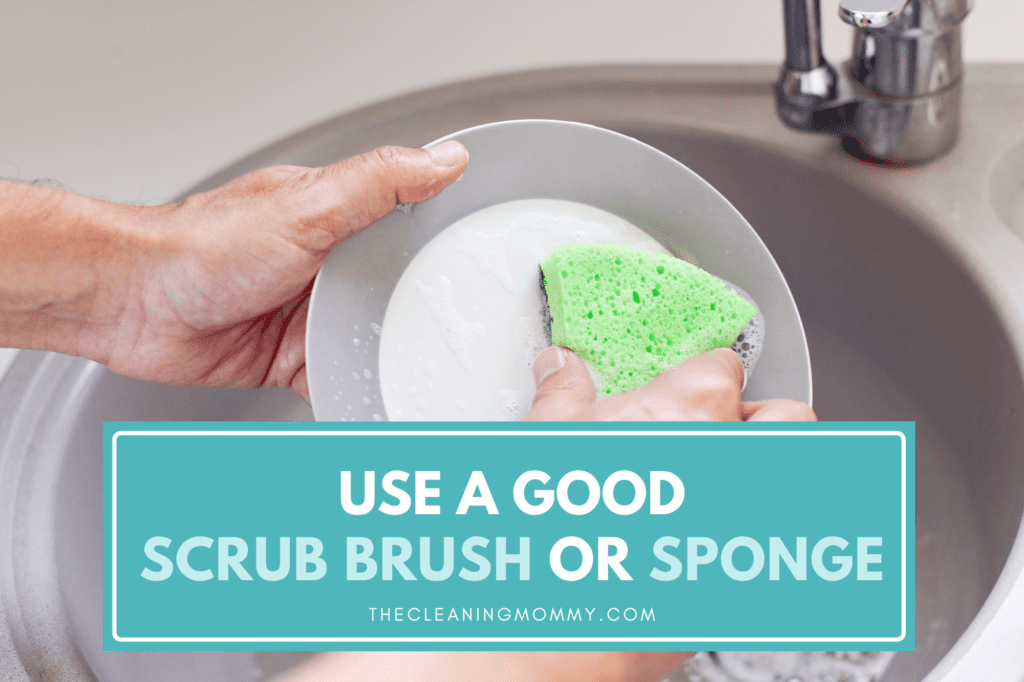
3. Use a Good Sponge/Scrubber
When I wash dishes, the sponge or dish brush I use usually depends on what exactly I’m cleaning. That being said, you want to invest in quality dishwashing tools.
I always look for dish brushes with long handles for reaching into narrow spaces. Palm brushes are great for large pots and pans, and cookware. A scrubby sponge or scouring pad made with a robust material is perfect for the dirtiest dishes with baked-on food.
4. Wear Gloves
Could you believe I never used to wear rubber gloves when washing wet dishes?
Over time I began to detest my dishpan hands-waterlogged and sometimes red from the sink. Nail polish? I didn’t know anything about that.
Since I started using dishwashing gloves, my hands are softer, and my skin is healthier. Plus, I can get a manicure and not cause my polish to chip away in a few days.
5. PRO TIP: Try Using Dishpans
Did you know it is unnecessary to have a double sink to clean dishes? Instead, you can use a dishpan to rinse dishes, soak stuck-on food, and disinfect the sink.
Dishpans will protect your dishes from chipping, even if they hit stainless steel, marble, or porcelain. Plus, it’s a game changer during the holidays when dishes are overwhelming, and you don’t have an empty sink to fill.

Washing Process Tips
Now that you know more about the various tools and methods you should be using let’s dive into the actual process itself. Yes, everyone does their dishes differently, but I do think my methods with the process can save you time, frustration, and maybe even money!
6. Scrape Off Food Residue First
Your garbage disposal has a very useful purpose. By not scraping your dishes completely before dunking them in the sink, you could create more work for yourself and severe plumbing issues.
Be sure to first scrape your plate, that grungy pan, and even that dirty pot from last night’s meal. I suggest a rubber spatula to avoid scratching glassware and Teflon pans.
If you don’t have a disposal, you can use a dirty bowl to fill with scraps. Then simply throw away the mess and wash the bowl.
7. Always Rinse Dishes Right Away
I never put unrinsed dishes in my sink of soapy water! I want all the food scraps and particles to go into the side of my double sink with the garbage disposal. This keeps my cleaning water clean and effective.
Plus, I always rinse my clean dishes after washing them. Naturally, while clean, they have soap residue. And you don’t want to serve meals on a dish with lingering soap!
If you want to avoid running water, I suggest a quick sanitizing of your double sink side with the disposal, then refilling that side with clean water. Then, you can dunk all your dishes (washed) in that side for a rinse, using less water (and saving money!). If you don’t have a double sink, use a large clean bowl as your rinsing area.
8. Make It a Fun Time
Need some quiet time or fun? Why not relax while those dirty bowls, pots, and pans soak
Soaking in hot soapy water helps break down grease and particles, especially burnt food and glassware with dairy products (like that baby bottle you just discovered hidden in the kid’s toybox?).
It’ll give you some downtime to do other things and make the job of cleaning much easier. Just don’t let that pan with burnt pancakes sit soaking so long your water turns cold!
What to do when you hate washing dishes?
Let’s face it, no-one enjoys washing dishes, but it’s a necessary evil. If you can, put on some music, or your favorite tv show, or listen to a podcast, so you are at least entertained while doing a mundane job!
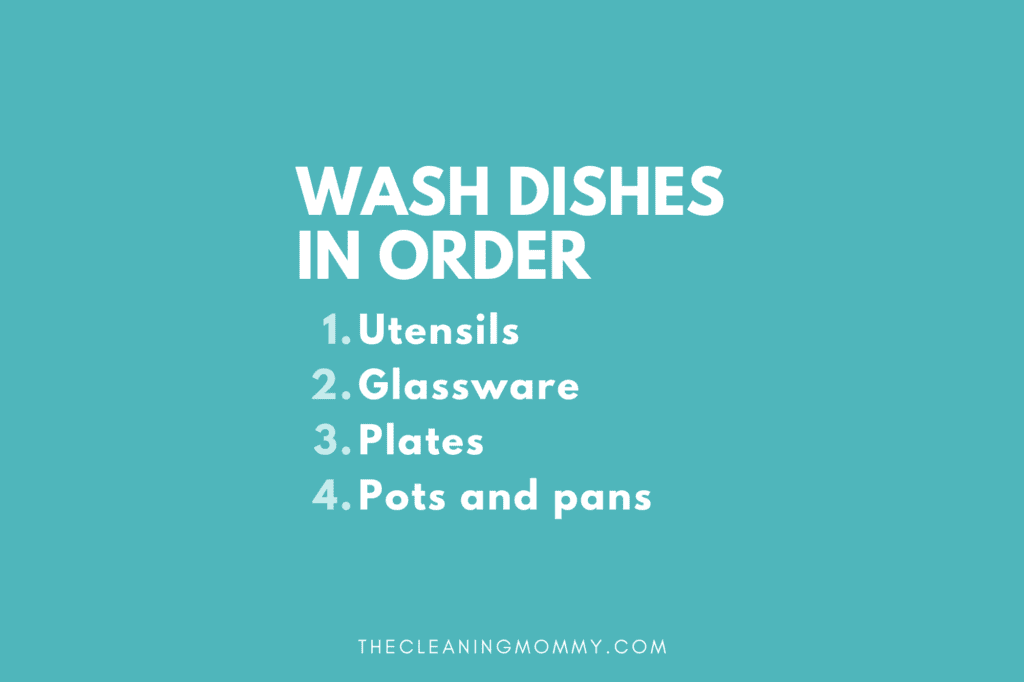
9. Wash Dishes In Order
Start by gathering all small utensils such as forks, knives, spoons, and any brewing tools like the French press coffee maker or drip cone that need washing.
Place flatware in a separate bowl of hot soapy water to soak while you move on to drinking items.
Drinking items include items like mugs, glasses, stemware, and pitchers. However fragile they may be, it’s essential to wash glassware first as they tend to be the most difficult items to clean due to their construction.
Begin by rinsing them off in warm water, followed by careful scrubbing using a soft bristle brush or a non-abrasive sponge. Rinse off the soap after washing each item and place aside on a drying rack or towel-lined surface until all pieces are finished being washed.
Now it’s time for plates—whether porcelain or stoneware—which you should place directly into the sink basin of warm soapy water; if needed, add a bit more detergent for extra cleaning power.
Scrub each plate one at a time using your sponge or bristle brush before rinsing with warm water and placing aside on the drying rack or towel-lined surface until complete. You can also use this same method for washing bowls; however, plates should always be washed prior to bowls due to their size difference.
Finally, it’s time for pots and pans, which generally require extra elbow grease due to their stickiness from residue still present on them after use. Submerge them into your basin, where you can vigorously wash with your brush and/or sponge paying special attention around handles where trapped debris may hide out!
Pots and pans are usually the messiest of all dishes, which is why they should always be washed last.
Air Dry: After all items are completely rinsed off, let them air dry naturally on either a dish drainer if you have the counter space, or dish cloths before putting them away for storage. If you don’t have much space to dry dishes, try this over-the-sink roll-up dish drying rack, once you’re done with it, it’s easily stored. Drying by hand allows you to inspect each item for any missed spots where grime might still remain; however, if you don’t have enough space for air drying, then using a lint-free towel is an option too – just make sure they’re always made clean before being used!
10. PRO TIP: Try Salt To Break Down Grease
You’d be surprised how effective salt is at getting grease from dishes. There are four things you’ll need:
- paper towels,
- coarse salt
- half lemon
- warm water
You should start by scraping everything off the dish and throwing it away. After that, wipe the grease off with paper towels.
Allow the coarse salt to sit for about 10 minutes on the greasy dishes or pans. After that, rub the salt into the dishes with the cut half of a lemon and let them sit for five more minutes. Rinse with warm water after wiping away the grime. To wash the dishes, you can either handwash them in the sink or use a dishwasher. Dry with a towel or allow to air dry. If you are using your dishwasher, be sure to include a good rinse aid.
Baking soda and vinegar are great at removing burnt food. If your dishes are greasy, sprinkle baking soda directly on them. Spray vinegar on top and let the mixture work for 30 minutes to loosen food particles and stains. The stains should lift off easily and quickly after scrubbing.
Final Thoughts
I still use my dishwasher to wash as many dishes as I can muster. But the above methods really do make the process easier! And saves money by not using the dishwasher.
More Articles on Cleaning
- how to clean a messy house step by step
- how to clean walls fast and easy
- best cloth for cleaning the kitchen

Grainne Foley
Grainne Foley is a wife and mother of 2 great kids. During her 5 years of full time RV travel, Grainne learned to become very efficient at household chores, in order to make time for family adventures. Now, back in a house, she has continued to create tools and techniques to help others lighten the load of household organization and cleaning.
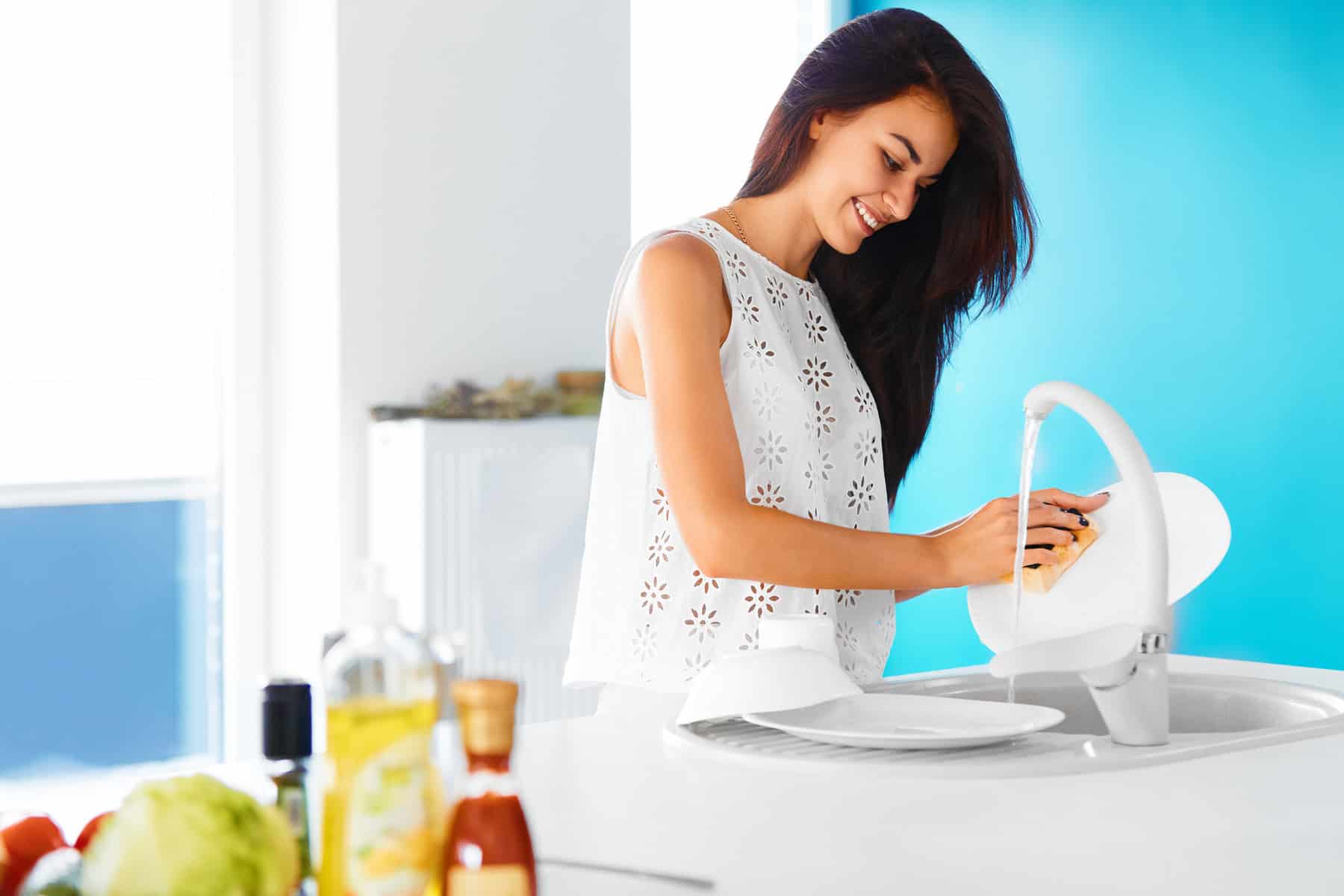
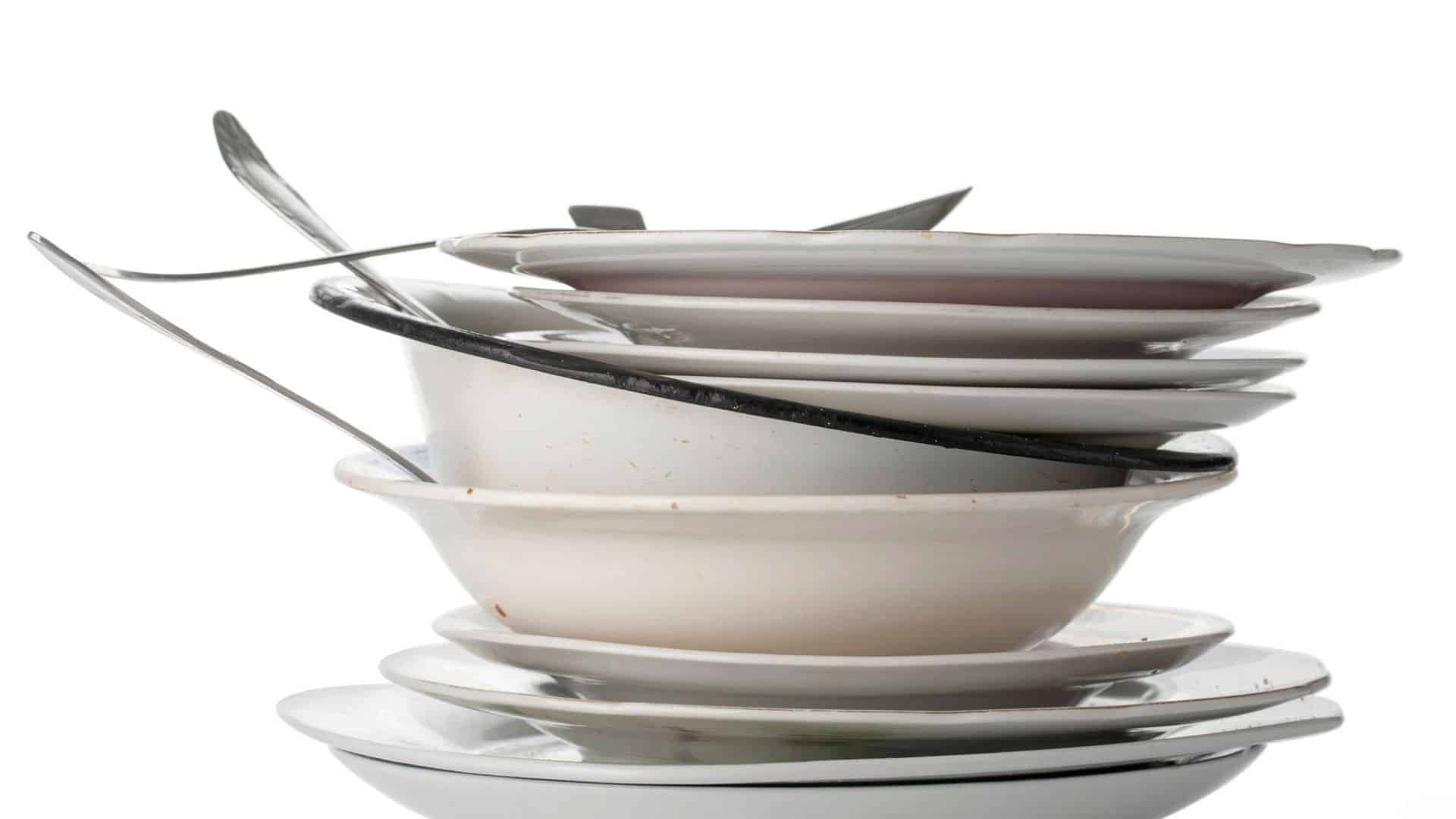



Leave a Reply